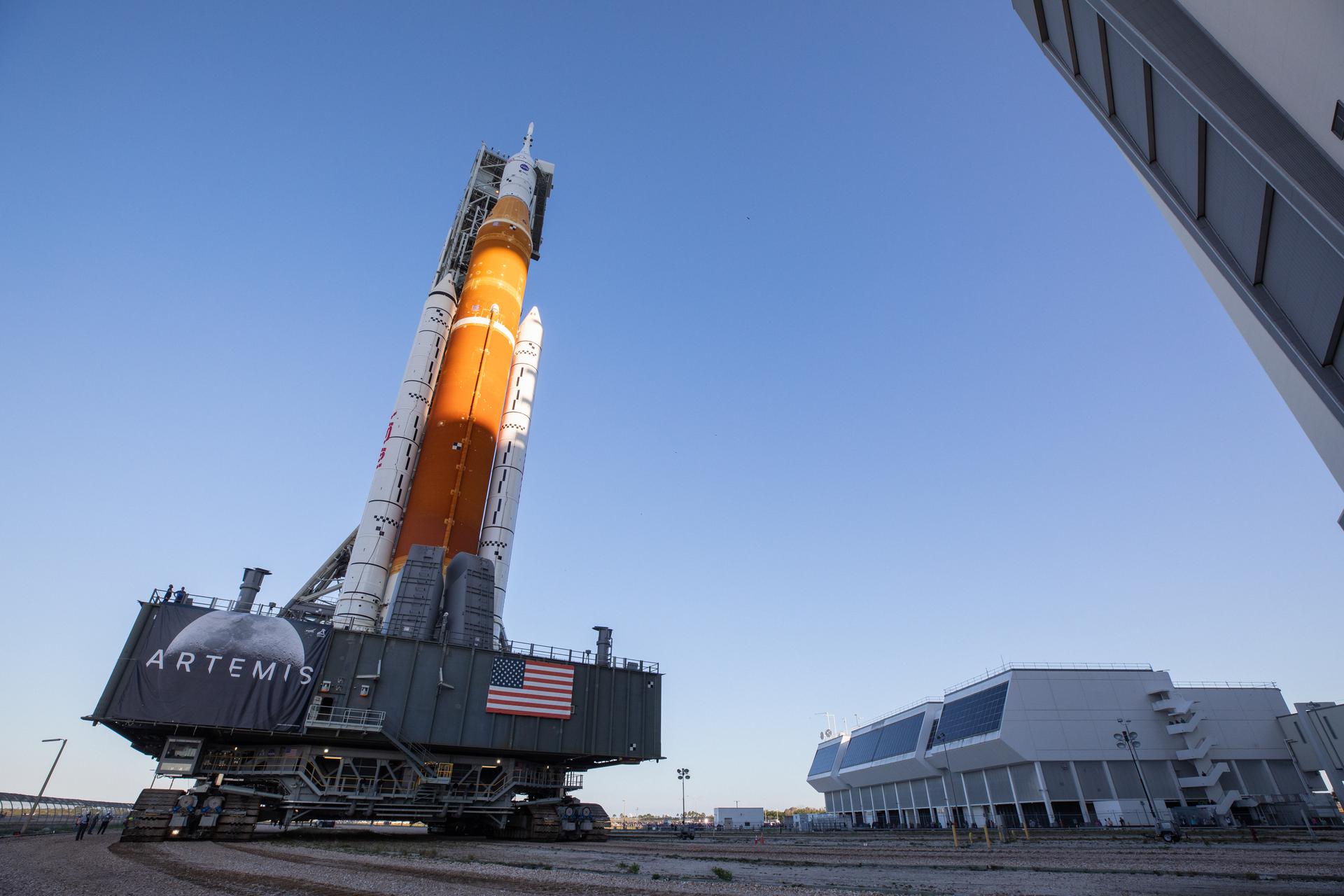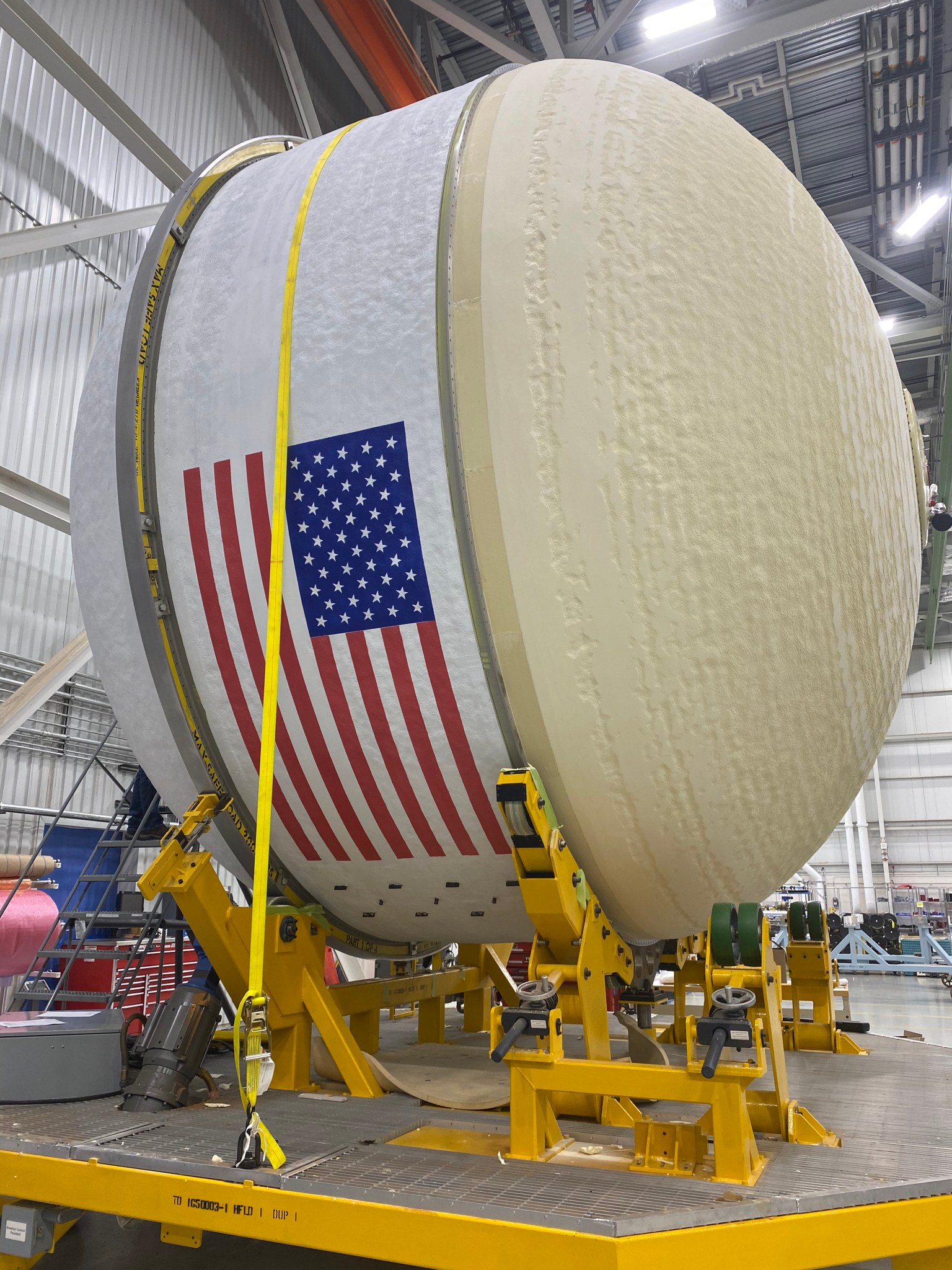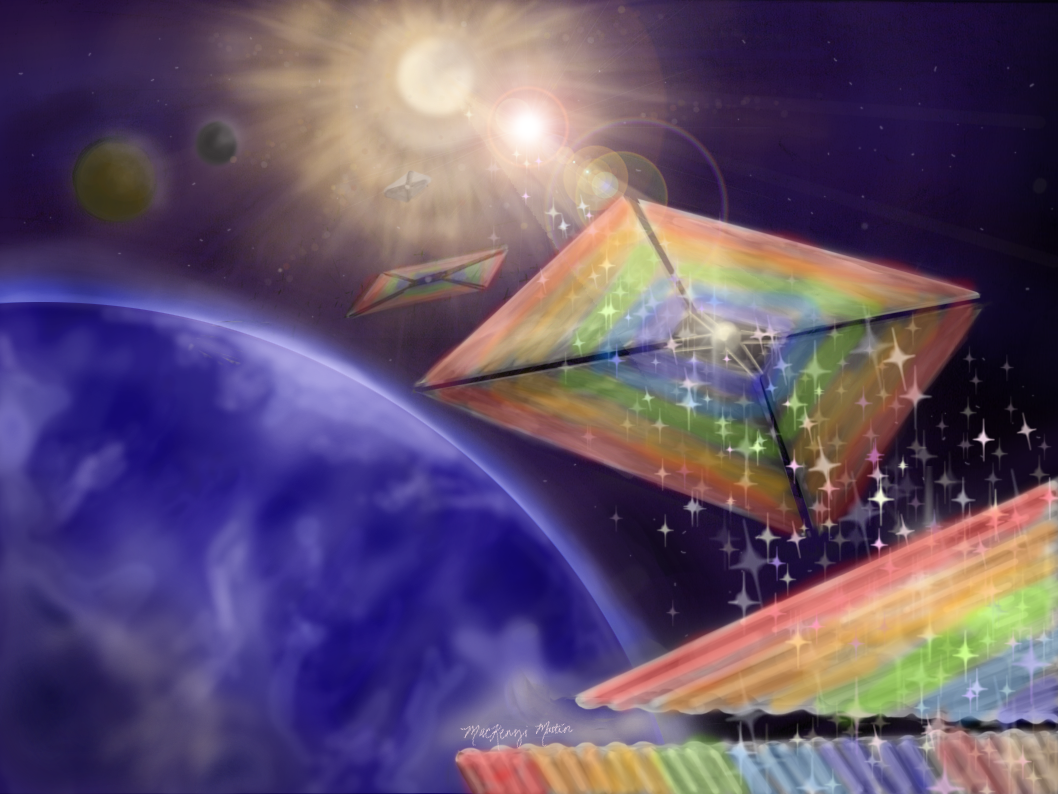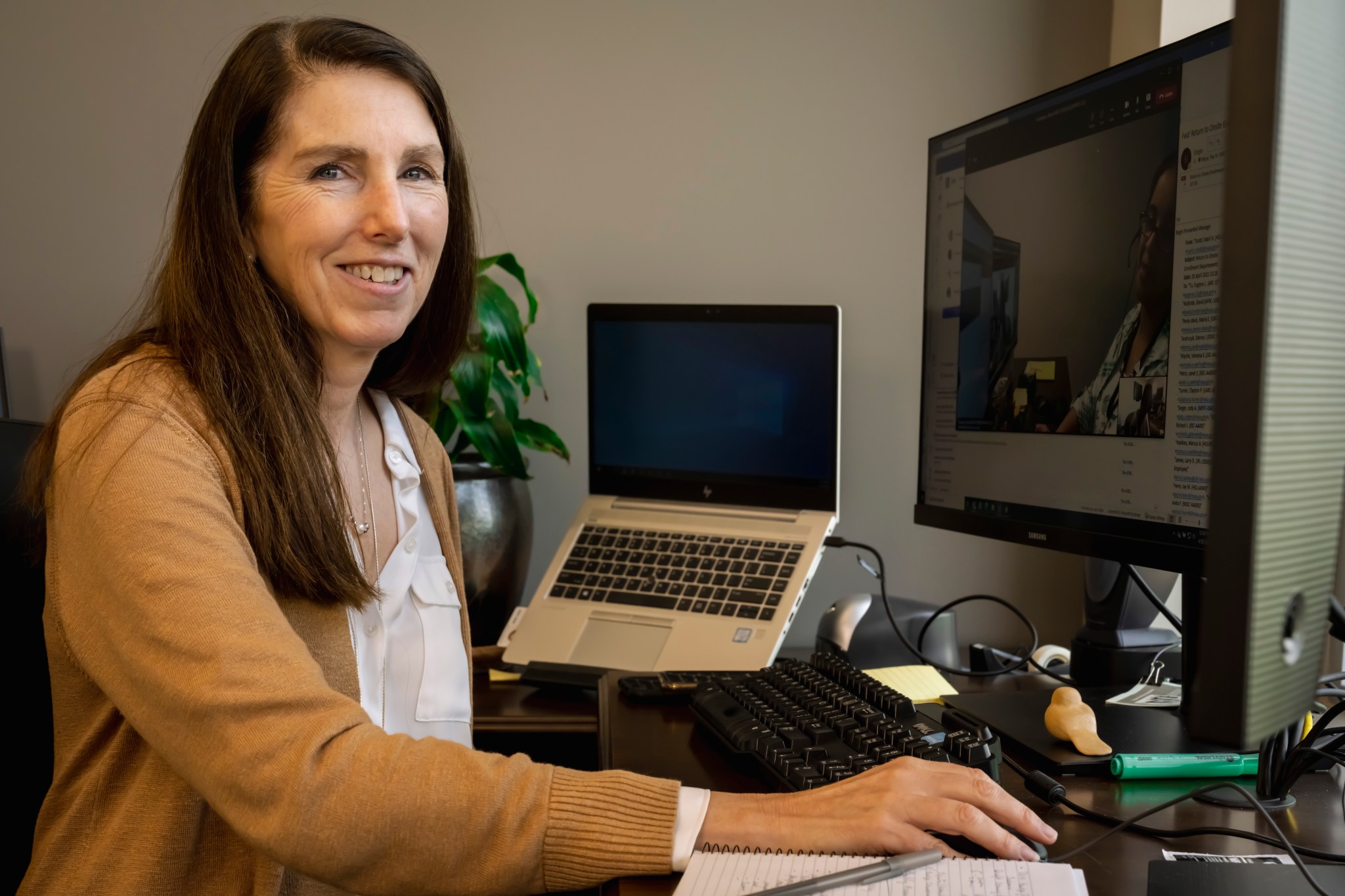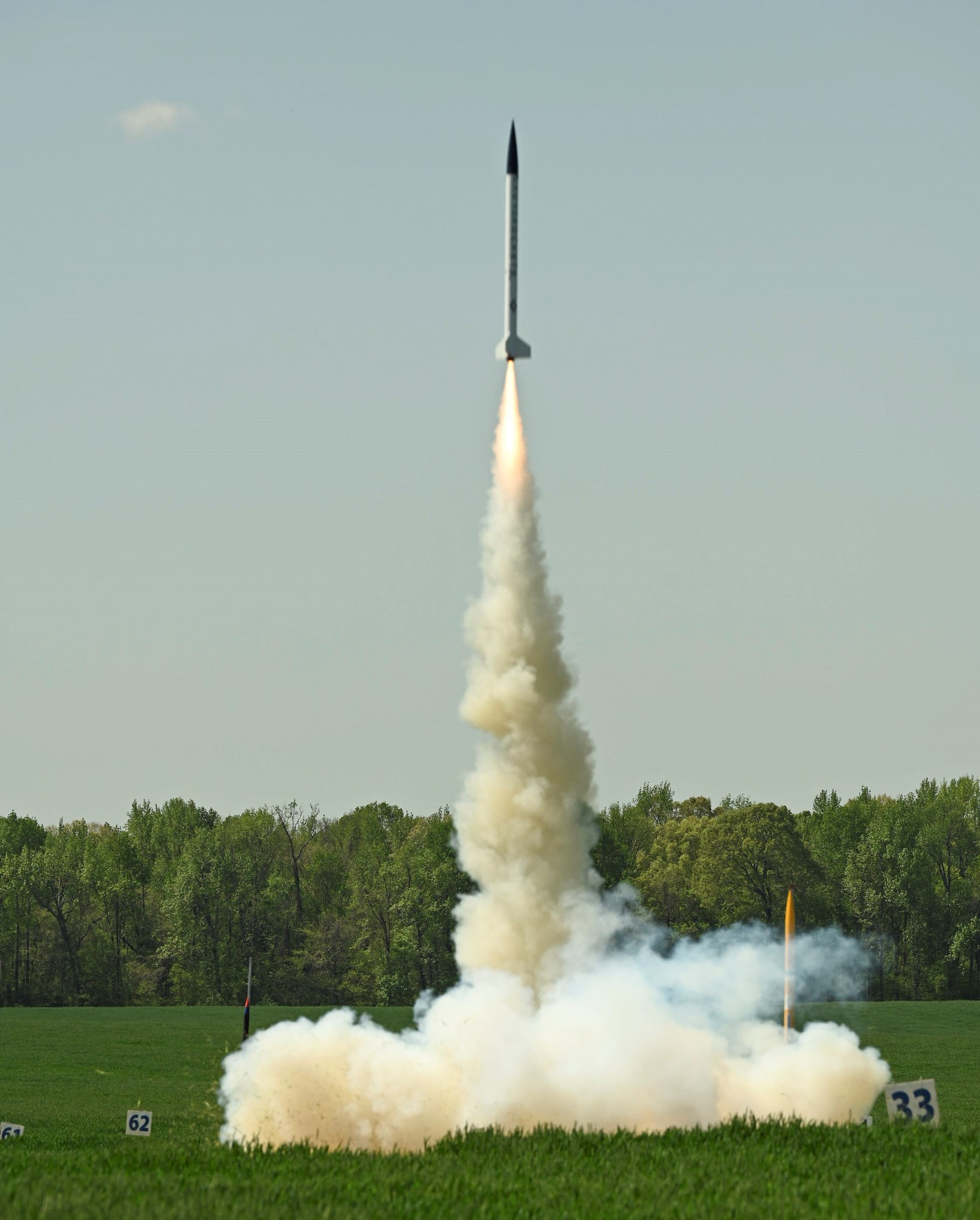Artemis I Moon Rocket to Roll June 6 for Next Tanking Test
The Space Launch System (SLS) rocket and Orion spacecraft are targeted to return to Launch Pad 39B at NASA’s Kennedy Space Center on June 6 for the next wet dress rehearsal attempt ahead of the Artemis I mission. First motion is currently slated for 12:01 a.m. June 6 with tanking operations to begin no earlier than June 19.
The rehearsal is the final test needed before launch and calls for NASA to load propellant into the rocket’s tanks, conduct a full launch countdown, demonstrate the ability to recycle the countdown clock, and drain the tanks to practice the timelines and procedures that will be used for launch.
While SLS and Orion were inside the Vehicle Assembly Building, teams completed several major objectives, including assessing the liquid hydrogen system leak at the tail service mast umbilical, replacing the interim cryogenic propulsion stage (ICPS) gaseous helium system check valve and support hardware, and modifying the ICPS umbilical purge boots. The addition of hazardous gas detectors above the upper stage allows for additional visibility into any potential leaks during cryogenic operations.
The hatches, or access points, of the crew module and launch abort system are now closed in preparation for rollout. Engineers installed rain gutters on the crew access area to help prevent moisture from entering the crew module while the spacecraft and rocket are at the launch pad. Teams have started retracting the service platforms that surround the Moon rocket and spacecraft in the Vehicle Assembly Building for rollout configuration ahead of their return to the launch pad.
NASA will provide livestream views of the SLS and Orion rollout from the Vehicle Assembly Building and arrival at Launch Pad 39B. For more information about the launch availability, visit here.
Upper Stage Propulsion System for Future Artemis Mission Reaches Major Milestone
While the Artemis I team prepares for its upcoming mission, NASA and contractor teams are already building rockets to support future Artemis Moon missions. In United Launch Alliance’s (ULA) factory in Decatur, Alabama, major components have been completed for the Artemis III interim cryogenic propulsion stage (ICPS) that will provide the power to send astronauts to the Moon. The ICPS, which is built by ULA under a collaborative partnership with Boeing, provides in-space propulsion for the Orion spacecraft after the solid rocket boosters and core stage put SLS into an Earth orbit, and before the spacecraft is flying on its own. The liquid hydrogen tank, above left, is built, and soon it will be mated to the intertank, above right, that connects it with the liquid oxygen tank. The intertank comprises composite-material truss structures in an X design. The eight bottles around the perimeter of the trusses store helium used to pressurize the stage’s propellant tanks. The liquid hydrogen and liquid oxygen tanks provide propellant for a single RL10 engine built by Aerojet Rocketdyne in West Palm Beach, Florida. The Artemis III ICPS will provide the big push needed to propel Orion toward the Moon and send the crew on the first mission where humans once again will land on the lunar surface. (United Launch Alliance)
NASA-Supported Solar Sail Could Take Science to New Heights
As NASA’s exploration continues to push boundaries, a new solar sail concept selected by the agency for development toward a demonstration mission could carry science to new destinations.
The Diffractive Solar Sailing project was selected for Phase III study under the NASA Innovative Advanced Concepts (NIAC) program. Phase III aims to strategically transition NIAC concepts with the highest potential impact for NASA, other government agencies, or commercial partners.
“As we venture farther out into the cosmos than ever before, we’ll need innovative, cutting-edge technologies to drive our missions,” NASA Administrator Bill Nelson said. “The NASA Innovative Advanced Concepts program helps to unlock visionary ideas – like novel solar sails – and bring them closer to reality.”
Like a sailboat using wind to cross the ocean, solar sails use the pressure exerted by sunlight to propel a craft through space. Existing reflective solar sail designs are typically very large and very thin, and they are limited by the direction of the sunlight, forcing tradeoffs between power and navigation. Diffractive lightsails would use small gratings embedded in thin films to take advantage of a property of light called diffraction, which causes light to spread out when it passes through a narrow opening. This would allow the spacecraft to make more efficient use of sunlight without sacrificing maneuverability.
“Exploring the universe means we need new instruments, new ideas, and new ways of going places,” said Jim Reuter, associate administrator for NASA’s Space Technology Mission Directorate at NASA Headquarters. “Our goal is to invest in those technologies throughout their lifecycle to support a robust ecosystem of innovation.”
The new Phase III award will give the research team $2 million over two years to continue technology development in preparation for a potential future demonstration mission. The project is led by Amber Dubill of the Johns Hopkins University Applied Physics Laboratory in Laurel, Maryland.
“NIAC allows us to foster some of the most creative technology concepts in aerospace,” said Mike LaPointe, acting program executive for the NIAC program at NASA Headquarters. “Our goal is to change the possible, and diffractive solar sailing promises to do just that for a number of exciting new mission applications.”
The feasibility of the concept was previously studied under NIAC’s Phase I and Phase II awards, led by Dr. Grover Swartzlander of Rochester Institute of Technology in New York, who continues as a co-investigator on the project. Les Johnson at NASA’s Marshall Space Flight Center is also a co-investigator. Under the earlier awards, the team designed, created, and tested different types of diffractive sail materials, conducted experiments, and designed new navigation and control schemes for a potential diffractive lightsail mission orbiting the Sun’s poles.
“Diffractive lightsails will extend the capability of solar sails beyond what is possible today to enable much more ambitious missions in the future,” said Johnson, lead for NASA’s upcoming Near Earth Asteroid Scout and Solar Cruiser missions.
Work under Phase III will optimize the sail material and perform ground tests in support of this conceptual solar mission. Orbits passing over the Sun’s north and south poles are difficult to achieve using conventional spacecraft propulsion. Lightweight diffractive lightsails, propelled by the constant pressure of sunlight, could place a constellation of science spacecraft in orbit around the Sun’s poles to advance our understanding of the Sun and improve space weather forecasting capabilities.
“Diffractive solar sailing is a modern take on the decades-old vision of lightsails. While this technology can improve a multitude of mission architectures, it is poised to highly impact the heliophysics community’s need for unique solar observation capabilities,” Dubill said. “With our team’s combined expertise in optics, aerospace, traditional solar sailing, and metamaterials, we hope to allow scientists to see the Sun as never before.”
NIAC supports visionary research ideas through multiple progressive phases of study. NASA announced 17 Phase I and Phase II proposal selections in February 2022. NIAC is funded by NASA’s Space Technology Mission Directorate, which is responsible for developing the new cross-cutting technologies and capabilities needed by the agency to achieve its current and future missions.
Marshall Associate Director Rae Ann Meyer Walks with Quiet Strength
By Tee Quillin
Rae Ann Meyer knows a thing or two about flexibility in leadership.
Meyer recently was tapped to be associate director of NASA’s Marshall Space Flight Center, but during her 33-year tenure at NASA, she has worn many different hats. She has served in positions from deputy manager of the Marshall Engineering Directorate’s Flight Mechanics and Analysis Division to deputy manager of the Science and Technology Office at Marshall. Meyer is no stranger to constant change. There is also a quiet grace with which she goes about handling that change.
Meyer is a self-proclaimed Navy brat. Born in San Diego, her family, like so many military families, was soon on the move. When Meyer was 10, her dad retired from the Navy, and the family settled in the shadow of Lookout Mountain in Chattanooga, Tennessee. She remained there until she graduated from high school and went off to the University of Tennessee in Knoxville, where she earned her bachelor’s degree in electrical engineering.
She is quick to point out that she is a quiet person and was “cripplingly shy as a child. I never talked in school.” One day, she overheard the teacher instructing the accelerated students on the science of the water cycle and she was immediately drawn in. “So, I went up to her – which took a lot of nerve for me,” Meyer said, “and I told her I wanted to be in the other class because I thought that was interesting.” Meyer was told she’d have to know her multiplication tables. So, after recess, her teacher called her in front of the class to go through them.
She missed one: 7×8.
At the end of the next week, her teacher quizzed her again – this time not in front of the class – and she found herself in the accelerated class, where she fell in love with science. That love, combined with a proclivity for math and a supportive new school system in Chattanooga, helped pave the way toward her pursuing studies in electrical engineering.
Meyer says she never really overcame her shyness, she just doesn’t let it get in her way. She found a way to use it to her advantage. She took her shy demeanor, combined it with her “never-give-up” attitude and developed it into a strong, quiet leadership style. Her shyness allows her to better connect with people, even when she has to step out from behind it. “Being a leader is more than just being firm or strict,” Meyer said.
Just after graduating from college, she took up an activity she always wanted to pursue: horseback riding. She quickly learned that it is a team sport, with the horse and rider functioning together as a unit. “If I was having a good day, but the horse was having an off day, we as a team were going to have an off day – until we learned to listen to and trust each other,” Meyer said. She has applied that lesson ever since, in all walks of life.
When Meyer started her new position earlier this year, she said that one of the challenges was transitioning as a leader in a remote work environment, an unprecedented paradigm shift in the COVID-19 era. Meyer’s office leads Marshall’s pandemic response, based on guidance from the White House and the Centers for Disease Control and Prevention.
“The actual work is the easy part.” Meyer said. “Our chief information officer has given us all of the tools we need to be able to work efficiently and safely from home. I need that personal connection with people when starting a new position like this.”
Yet, throughout all the uncertainty, Meyer has not shied away from taking the helm and has remained flexible while navigating her team through the many changes and challenges that have presented themselves.
Quillin, a Media Fusion employee, supports Marshall’s Office of Strategic Analysis & Communications.
NASA to Announce Winners of 2022 Student Launch Competition June 2
NASA will announce the winners of this year’s Student Launch rocketry competition in a live virtual awards ceremony June 2 beginning at 1 p.m. CDT. The ceremony can be viewed via the Student Launch Facebook page, as well as the YouTube page for NASA’s Marshall Space Flight Center.
Student Launch is an annual competition that typically culminates each April with a gathering of teams for a weekend of rocket launches and celebration. This year, teams had the choice of competing April 23 near Marshall or launching from a home field.
Student Launch challenges middle school, high school, college, and university students from across the United States and Puerto Rico to design, build, and test a high-powered amateur rocket, fly it to an altitude between 4,000 and 6,000 feet, and make a successful landing. Teams compete in collegiate or middle school/high school divisions, and are scored in nearly a dozen categories, including altitude, safety, vehicle design, social media presence, and more.
For the 2022 season, college/university teams were tasked with designing a payload capable of autonomously locating where their rocket landed by identifying the rocket’s grid position on an aerial image of the launch site, while transmitting the data back to their ground station. This had to be accomplished without the use of GPS. Middle/high school teams could choose to attempt the college/university division challenge or develop their own science or engineering experiment.
NASA’s Southeast Regional Office of STEM Engagement at Marshall manages Student Launch, one of the agency’s Artemis Student Challenges. These activities stimulate innovation and advance NASA’s human exploration mission through collaboration with educational institutions and students – the Artemis Generation, who will help NASA explore the Moon and Mars.


























